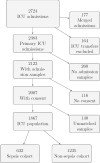Circulating bioactive adrenomedullin as a marker of sepsis, septic shock and critical illness
- PMID: 33148300
- PMCID: PMC7641835
- DOI: 10.1186/s13054-020-03351-1
Circulating bioactive adrenomedullin as a marker of sepsis, septic shock and critical illness
Abstract
Background: Biomarkers can be of help to understand critical illness and to identify and stratify sepsis. Adrenomedullin is a vasoactive hormone, with reported prognostic and potentially therapeutic value in sepsis. The primary aim of this study was to investigate the association of circulating bioactive adrenomedullin (bio-ADM) levels at intensive care unit (ICU) admission with mortality in sepsis patients and in a general ICU population. Secondary aims included the association of bio-ADM with organ failure and the ability of bio-ADM to identify sepsis.
Methods: In this retrospective observational study, adult patients admitted to one of four ICUs during 2016 had admission bio-ADM levels analysed. Age-adjusted odds ratios (OR) with 95% CI for log-2 transformed bio-ADM, and Youden's index derived cut-offs were calculated. The primary outcome was 30-day mortality, and secondary outcomes included the need for organ support and the ability to identify sepsis.
Results: Bio-ADM in 1867 consecutive patients were analysed; 632 patients fulfilled the sepsis-3 criteria of whom 267 had septic shock. The median bio-ADM in the entire ICU population was 40 pg/mL, 74 pg/mL in sepsis patients, 107 pg/mL in septic shock and 29 pg/mL in non-septic patients. The association of elevated bio-ADM and mortality in sepsis patients and the ICU population resulted in ORs of 1.23 (95% CI 1.07-1.41) and 1.22 (95% CI 1.12-1.32), respectively. The association with mortality remained after additional adjustment for lactate in sepsis patients. Elevated bio-ADM was associated with an increased need for dialysis with ORs of 2.28 (95% CI 2.01-2.59) and 1.97 (95% CI 1.64-2.36) for the ICU population and sepsis patients, respectively, and with increased need of vasopressors, OR 1.33 (95% CI 1.23-1.42) (95% CI 1.17-1.50) for both populations. Sepsis was identified with an OR of 1.78 (95% CI 1.64-1.94) for bio-ADM, after additional adjustment for severity of disease. A bio-ADM cut-off of 70 pg/mL differentiated between survivors and non-survivors in sepsis, but a Youden's index derived threshold of 108 pg/mL performed better.
Conclusions: Admission bio-ADM is associated with 30-day mortality and organ failure in sepsis patients as well as in a general ICU population. Bio-ADM may be a morbidity-independent sepsis biomarker.
Keywords: Adrenomedullin; Bioactive adrenomedullin; Biomarkers; Critical illness; Cut-off; Sepsis; Septic shock.
Conflict of interest statement
OL, ML, MS, MA, HL, AF and HF declare that they have no competing interests, no financial or any other interests in SphingoTec GmbH and have not been in any way influenced by SphingoTec GmbH in writing this research paper. OM is listed as an inventor on a patent on bio-ADM in dementia prediction. SphingoTec GmbH is the owner of the patent. DB and JS are employed by SphingoTec GmbH and participate in the company’s employee stock option program. Bioactive ADM was analysed free of charge by SphingoTec GmbH, Neuendorfstrae 15A, 16761 Hennigsdorf, Germany.
Figures




Similar articles
-
Bioactive adrenomedullin in sepsis patients in the emergency department is associated with mortality, organ failure and admission to intensive care.PLoS One. 2022 Apr 28;17(4):e0267497. doi: 10.1371/journal.pone.0267497. eCollection 2022. PLoS One. 2022. PMID: 35482727 Free PMC article.
-
Circulating adrenomedullin estimates survival and reversibility of organ failure in sepsis: the prospective observational multinational Adrenomedullin and Outcome in Sepsis and Septic Shock-1 (AdrenOSS-1) study.Crit Care. 2018 Dec 21;22(1):354. doi: 10.1186/s13054-018-2243-2. Crit Care. 2018. PMID: 30583748 Free PMC article.
-
Clinical value of circulating bioactive adrenomedullin for prediction of outcome and hydrocortisone response in sepsis patients-a post-hoc analysis of the HYPRESS trial.Infection. 2025 May 30. doi: 10.1007/s15010-025-02569-x. Online ahead of print. Infection. 2025. PMID: 40447978
-
Bio-Adrenomedullin and Dipeptidyl Peptidase 3 as Novel Sepsis Biomarkers in the Emergency Department and the Intensive Care Unit: A Narrative Review.Medicina (Kaunas). 2025 Jun 9;61(6):1059. doi: 10.3390/medicina61061059. Medicina (Kaunas). 2025. PMID: 40572747 Free PMC article. Review.
-
Midregional-proAdrenomedullin as a prognostic tool in sepsis and septic shock: A systematic review and meta-analysis.Eur J Clin Invest. 2024 Sep;54(9):e14225. doi: 10.1111/eci.14225. Epub 2024 Apr 17. Eur J Clin Invest. 2024. PMID: 38632681
Cited by
-
Bioactive Adrenomedullin in Dogs with Sepsis and Septic Shock: A Prospective, Case-Control Study.Animals (Basel). 2024 Oct 23;14(21):3054. doi: 10.3390/ani14213054. Animals (Basel). 2024. PMID: 39518777 Free PMC article.
-
Plasma bioactive adrenomedullin predicts mortality and need for dialysis in critical COVID-19.Sci Rep. 2024 Oct 11;14(1):23787. doi: 10.1038/s41598-024-74380-x. Sci Rep. 2024. PMID: 39394248 Free PMC article.
-
Bioactive adrenomedullin in sepsis patients in the emergency department is associated with mortality, organ failure and admission to intensive care.PLoS One. 2022 Apr 28;17(4):e0267497. doi: 10.1371/journal.pone.0267497. eCollection 2022. PLoS One. 2022. PMID: 35482727 Free PMC article.
-
Plasma bioactive adrenomedullin on intensive care unit admission is associated with acute respiratory distress syndrome: an observational study.Intensive Care Med Exp. 2023 Mar 3;11(1):10. doi: 10.1186/s40635-023-00494-7. Intensive Care Med Exp. 2023. PMID: 36864354 Free PMC article.
-
Optical Bionanosensors for Sepsis Diagnostics.Small. 2025 Feb;21(8):e2409042. doi: 10.1002/smll.202409042. Epub 2025 Jan 2. Small. 2025. PMID: 39745136 Free PMC article. Review.
References
-
- World Health Organization: Improving the prevention, diagnosis and clinical management of sepsis: report by the secretariat, 6 (2017)
-
- Seymour CW, Kennedy JN, Wang S, Chang CH, Elliott CF, Xu Z, Berry S, Clermont G, Cooper G, Gomez H, Huang DT, Kellum JA, Mi Q, Opal SM, Talisa V, van der Poll T, Visweswaran S, Vodovotz Y, Weiss JC, Yealy DM, Yende S, Angus DC. Derivation, validation, and potential treatment implications of novel clinical phenotypes for sepsis. JAMA. 2019;321(20):2003–17. doi: 10.1001/jama.2019.5791. - DOI - PMC - PubMed
-
- Samson WK, Resch ZT, Murphy TC, Vargas TT, Schell DA. Adrenomedullin: is there physiological relevance in the pathology and pharmacology? News Physiol Sci. 1999;14:255–259. - PubMed
Publication types
MeSH terms
Substances
LinkOut - more resources
Full Text Sources
Other Literature Sources
Medical

